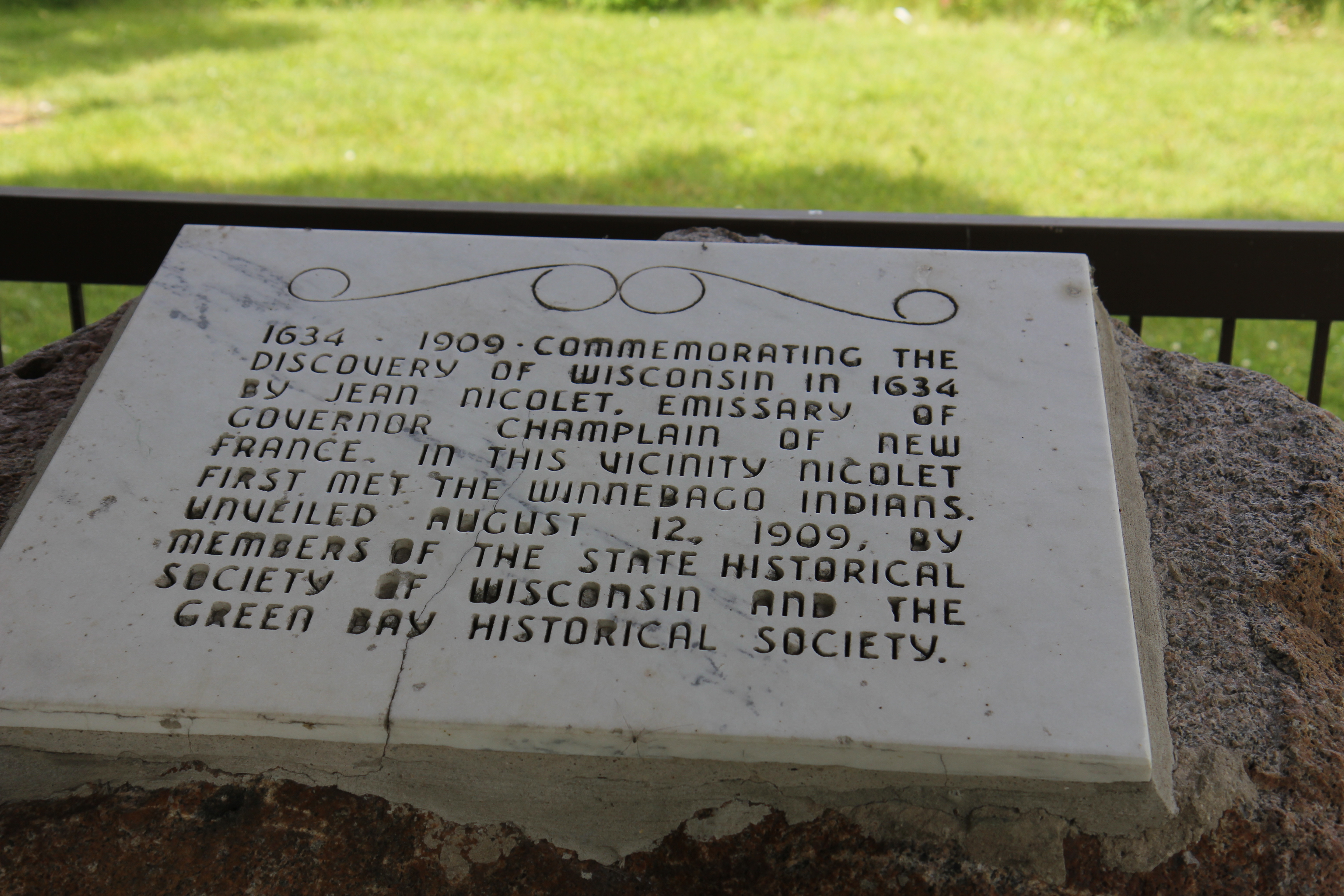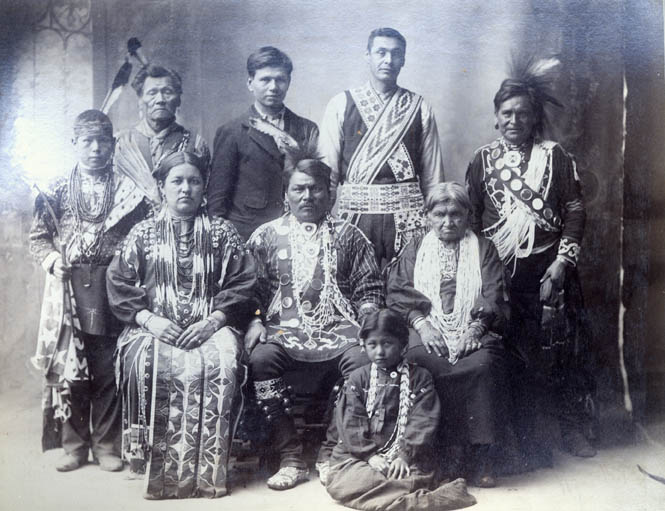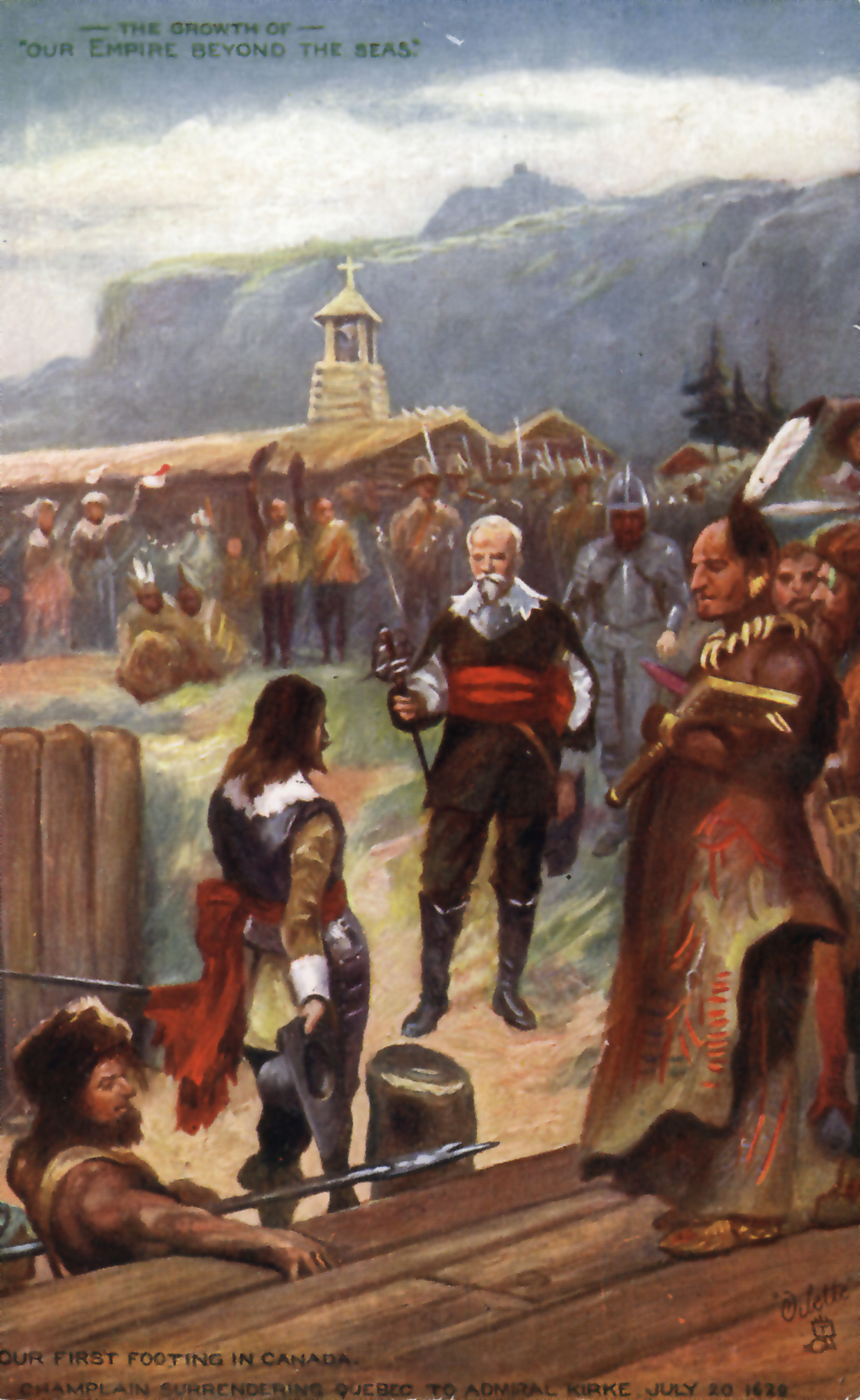|
Jean Nicolet
Jean Nicolet (Nicollet), Sieur de Belleborne (159829 October 1642) was a French ''coureur des bois'' noted for exploring Lake Michigan, Mackinac Island, Green Bay, and being the first European to set foot in what is now the U.S. state of Wisconsin. Early life Nicolet (Nicollet) was born in Cherbourg, France, in the late 1590s, the son of Thomas Nicollet, who was "messenger ordinary of the King between Paris and Cherbourg", and Marguerite de Lamer. They were members of the Roman Catholic Church. He was a known friend of Samuel de Champlain and Étienne Brûlé, Étienne Brule, and was attracted to Canada to participate in Champlain's plan to train young French men as explorers and traders by having them live among Native Americans, at a time when the French were setting up fur trading under the ''Compagnie des Marchands.''Andreas, Alfred Theodore (1884; 1975 rprt)''History of Chicago'' Vol. I, p. 39. Arno Press, Inc. Arrival at Quebec In 1618, Nicolet immigrated to Quebec as ... [...More Info...] [...Related Items...] OR: [Wikipedia] [Google] [Baidu] |
Cherbourg
Cherbourg is a former Communes of France, commune and Subprefectures in France, subprefecture located at the northern end of the Cotentin peninsula in the northwestern French departments of France, department of Manche. It was merged into the commune of Cherbourg-Octeville on 28 February 2000,Décret 23 February 2000 which was merged into the new commune of Cherbourg-en-Cotentin on 1 January 2016. Cherbourg is protected by Cherbourg Harbour, between La Hague and Val de Saire, and the city has been a strategic position over the centuries, disputed between the English and French. Cited as one of the "keys to the kingdom" by Sébastien Le Prestre de Vauban, Vauban, it became, by colossal maritime development work, a first-rate military port under the ... [...More Info...] [...Related Items...] OR: [Wikipedia] [Google] [Baidu] |
Algonquin People
The Algonquin people are an Indigenous people who now live in Eastern Canada and parts of the United States. They speak the Algonquin language, which is part of the Algonquian language family. Culturally and linguistically, they are closely related to the Odawa, Potawatomi, Ojibwe (including Oji-Cree), Mississaugas, and Nipissing, with whom they form the larger Anicinàpe (Anishinaabeg) group. Algonquins are known by many names, including Omàmiwinini (plural: Omàmiwininiwak, "downstream man/men") and Abitibiwinni (pl.: Abitibiwinnik "men ivinghalfway across the water") or the more generalised name of Anicinàpe. Though known by several names in the past, such as ''Algoumequin'', the most common term "Algonquin" has been suggested to derive from the Maliseet word (): "they are our relatives/allies." The much larger heterogeneous group of Algonquian-speaking peoples, who, according to Brian Conwell, stretch from Virginia to the Rocky Mountains and north to Hudson ... [...More Info...] [...Related Items...] OR: [Wikipedia] [Google] [Baidu] |
Fox River (Green Bay Tributary)
The Fox River is a river in eastern Wisconsin in the Great Lakes region of the United States. It is the principal tributary of the Green Bay (Lake Michigan), Green Bay, and via the bay, the largest tributary of Lake Michigan. The city of Green Bay, Wisconsin, Green Bay, one of the first European settlements in the interior of North America, is on the river at its mouth on the Green Bay. Hydrographers divide the Fox into two distinct sections, the Upper Fox River, flowing from its headwaters in south-central Wisconsin northeasterly into Lake Winnebago, and the Lower Fox River, flowing from Lake Winnebago northeasterly to the Green Bay. Together, the two sections give the Fox River a length of . Counting the distance through Lake Winnebago gives a total of . The river's name is the English translation of the French name for the Meskwaki, Meskwaki people in the 17th century. The river was part of the famous 1673–74 expedition of Louis Jolliet, Jolliet and Jacques Marquett ... [...More Info...] [...Related Items...] OR: [Wikipedia] [Google] [Baidu] |
Pacific Ocean
The Pacific Ocean is the largest and deepest of Earth's five Borders of the oceans, oceanic divisions. It extends from the Arctic Ocean in the north to the Southern Ocean, or, depending on the definition, to Antarctica in the south, and is bounded by the continents of Asia and Australia in the west and the Americas in the east. At in area (as defined with a southern Antarctic border), the Pacific Ocean is the largest division of the World Ocean and the hydrosphere and covers approximately 46% of Earth's water surface and about 32% of the planet's total surface area, larger than its entire land area ().Pacific Ocean . ''Encyclopædia Britannica, Britannica Concise.'' 2008: Encyclopædia Britannica, Inc. The centers of both the Land and water hemispheres, water hemisphere and the Western Hemisphere, as well as the Pole of inaccessi ... [...More Info...] [...Related Items...] OR: [Wikipedia] [Google] [Baidu] |
Ho-Chunk
The Ho-Chunk, also known as Hocąk, Hoocągra, or Winnebago are a Siouan languages, Siouan-speaking Native Americans in the United States, Native American people whose historic territory includes parts of Wisconsin, Minnesota, Iowa, and Illinois. Today, Ho-Chunk people are enrolled in two federally recognized tribes, the Ho-Chunk Nation of Wisconsin and the Winnebago Tribe of Nebraska. Historically, the surrounding Algonquian peoples, Algonquin tribes referred to them by a term that evolved to Winnebago, which was later used as well as by the French and English. The Ho-Chunk Nation have always called themselves Ho-Chunk. The name ''Ho-Chunk'' comes from the word ''Hoocąk'' and "Hoocąkra," (''Ho'' meaning "voice", ''cąk'' meaning "sacred", ''ra'' being a definitive article) meaning "People of the Sacred Voice". Their name comes from oral traditions that state they are the originators of the many branches of the Siouan language. The Ho-Chunk claim descendancy from both the effig ... [...More Info...] [...Related Items...] OR: [Wikipedia] [Google] [Baidu] |
Green Bay, Wisconsin
Green Bay is a city in Brown County, Wisconsin, United States, and its county seat. It is located at the head of Green Bay (Lake Michigan), Green Bay (known locally as "the bay of Green Bay"), a sub-basin of Lake Michigan at the mouth of the Fox River (Green Bay tributary), Fox River. Green Bay had a population of 107,395 at the 2020 United States census, 2020 census, making it the List of cities in Wisconsin, third-most populous city in Wisconsin (after Milwaukee and Madison, Wisconsin, Madison) and the third-most populous city on Lake Michigan (after Chicago and Milwaukee). The Green Bay metropolitan area covers Brown, Kewaunee County, Wisconsin, Kewaunee, and Oconto County, Wisconsin, Oconto counties and had a population of 320,050 in 2020. Green Bay was settled in 1634 by Jean Nicolet as a fur trading post in New France. Its development was shaped by its location at the mouth of the Fox River and it emerged as a center for the lumber, shipping, and paper industries in the 1 ... [...More Info...] [...Related Items...] OR: [Wikipedia] [Google] [Baidu] |
Red Banks, Brown County, Wisconsin
Red Banks is an unincorporated community located in the town of Scott, Brown County, Wisconsin Wisconsin ( ) is a U.S. state, state in the Great Lakes region, Great Lakes region of the Upper Midwest of the United States. It borders Minnesota to the west, Iowa to the southwest, Illinois to the south, Lake Michigan to the east, Michig ..., United States. History In 1634, Jean Nicolet landed at Red Banks becoming the first European to explore the present state of Wisconsin. Notes Unincorporated communities in Brown County, Wisconsin Unincorporated communities in Wisconsin {{BrownCountyWI-geo-stub ... [...More Info...] [...Related Items...] OR: [Wikipedia] [Google] [Baidu] |
Jean Nicolet Commerative Plaque At Red Banks WI From 1909
Jean may refer to: People * Jean (female given name) * Jean (male given name) * Jean (surname) Fictional characters * Jean Grey, a Marvel Comics character * Jean Valjean, fictional character in novel ''Les Misérables'' and its adaptations * Jean Pierre Polnareff, a fictional character from ''JoJo's Bizarre Adventure'' * Jean Luc Picard, fictional character from ''Star Trek Next Generation'' Places * Jean, Nevada, United States; a town * Jean, Oregon, United States Entertainment * Jean (dog), a female collie in silent films * "Jean" (song) (1969), by Rod McKuen, also recorded by Oliver * ''Jean Seberg'' (musical), a 1983 musical by Marvin Hamlisch Other uses * JEAN (programming language) * USS ''Jean'' (ID-1308), American cargo ship c. 1918 * Sternwheeler Jean, a 1938 paddleboat of the Willamette River See also *Jehan * * Gene (other) * Jeanne (other) * Jehanne (other) * Jeans (other) * John (other) John is a common Eng ... [...More Info...] [...Related Items...] OR: [Wikipedia] [Google] [Baidu] |
Louis Hébert
Louis Hébert (; c. 1575 – 25 January 1627) is widely considered the first European apothecary in the region that would later become Canada, as well as the first European to farm in said region. He was born around 1575 at 129 de la rue Saint-Honoré in Paris to Nicolas Hébert and Jacqueline Pajot. He loved another woman but according to his father's wish he married Marie Rollet on 19 February 1601 at the Church of Saint-Sulpice, Paris. In 1606, he accompanied his cousin-in-law, Jean de Biencourt de Poutrincourt et de Saint-Just, to Acadia, along with Samuel de Champlain. He lived at Port-Royal (Acadia), Port Royal (now Annapolis Royal, in southern Nova Scotia) from 1606 to 1607 and from 1611 to 1613 when the habitation at Port Royal was destroyed by the English deputy governor of Virginia Samuel Argall. In 1617, with his wife, Marie Rollet, and their three children– Guillaume, aged three; Guillaumette, aged nine; and Anne, aged 14 – he left Paris forever to live ... [...More Info...] [...Related Items...] OR: [Wikipedia] [Google] [Baidu] |
Wyandot People
The Wyandot people (also Wyandotte, Wendat, Waⁿdát, or Huron) are an Indigenous people of the Northeastern Woodlands of the present-day United States and Canada. Their Wyandot language belongs to the Iroquoian languages, Iroquoian language family. In Canada, the Huron-Wendat Nation has two First Nations in Canada, First Nations Indian reserve, reserves at Wendake, Quebec. In the United States, the Wyandotte Nation is a federally recognized tribe headquartered in Wyandotte, Oklahoma. There are also List of organizations that self-identify as Native American tribes, organizations that self-identify as Wyandot. The Wendat emerged as a confederacy of five nations in the St. Lawrence River Valley, especially in Southern Ontario, including the north shore of Lake Ontario. Their original homeland extended to the Georgian Bay of Lake Huron and Lake Simcoe in Ontario, Canada and occupied territory around the western part of the lake. The Wyandotte Nation (the U.S. Tribe) descends f ... [...More Info...] [...Related Items...] OR: [Wikipedia] [Google] [Baidu] |
David Kirke
Sir David Kirke ( – ) was an English privateer and colonial administrator who served as the Governor of Newfoundland from 1638 to 1651. He is best known for capturing Québec from the French in 1629 during the Anglo-French War. A favourite of Charles I of England, Kirke's downfall came in 1651 when he was arrested after being accused of withholding taxes collected on behalf of the English government. Kirke was sent back to England, where he reportedly died in prison. Early life Kirke was a son of Gervase (Jarvis) Kirke, a rich merchant of the City of London, and Elizabeth Goudon, a French Huguenot woman. He was raised in Dieppe, in Normandy. Also David was the eldest of five sons, followed by Lewis, Thomas, John and James. While still in England, David married to Sara Kirke. They left for Newfoundland in 1638 and had a number of children, including their sons George, David the Younger, and Phillip. Quebec campaign An English fleet, consisting of six warships and three ... [...More Info...] [...Related Items...] OR: [Wikipedia] [Google] [Baidu] |
Lake Nipissing
Lake Nipissing (; , ) is a lake in the Provinces and territories of Canada, Canadian province of Ontario. It has a surface area of , a mean elevation of above sea level, and is located between the Ottawa River and Georgian Bay. Lake Nipissing is the third-largest lake entirely in Ontario. It is relatively shallow for a large lake, with an average depth of only . The shallowness of the lake makes for many Shoal, sandbars along the lake's irregular shoreline. The lake reaches a maximum depth of 64 m (210 ft) near the mouth of the French River (Ontario), French River, off the shore of Blueberry Island. The lake has many islands most of which are protected under the Protection of Significant Wetlands scheme, controlled by the Ministry of Natural Resources and Forestry. The largest population centre on the lake's shoreline is the city of North Bay, Ontario, North Bay. North Bay sits along the lake's northeastern shoreline. Other notable towns include Callander, Ontario, Cal ... [...More Info...] [...Related Items...] OR: [Wikipedia] [Google] [Baidu] |







